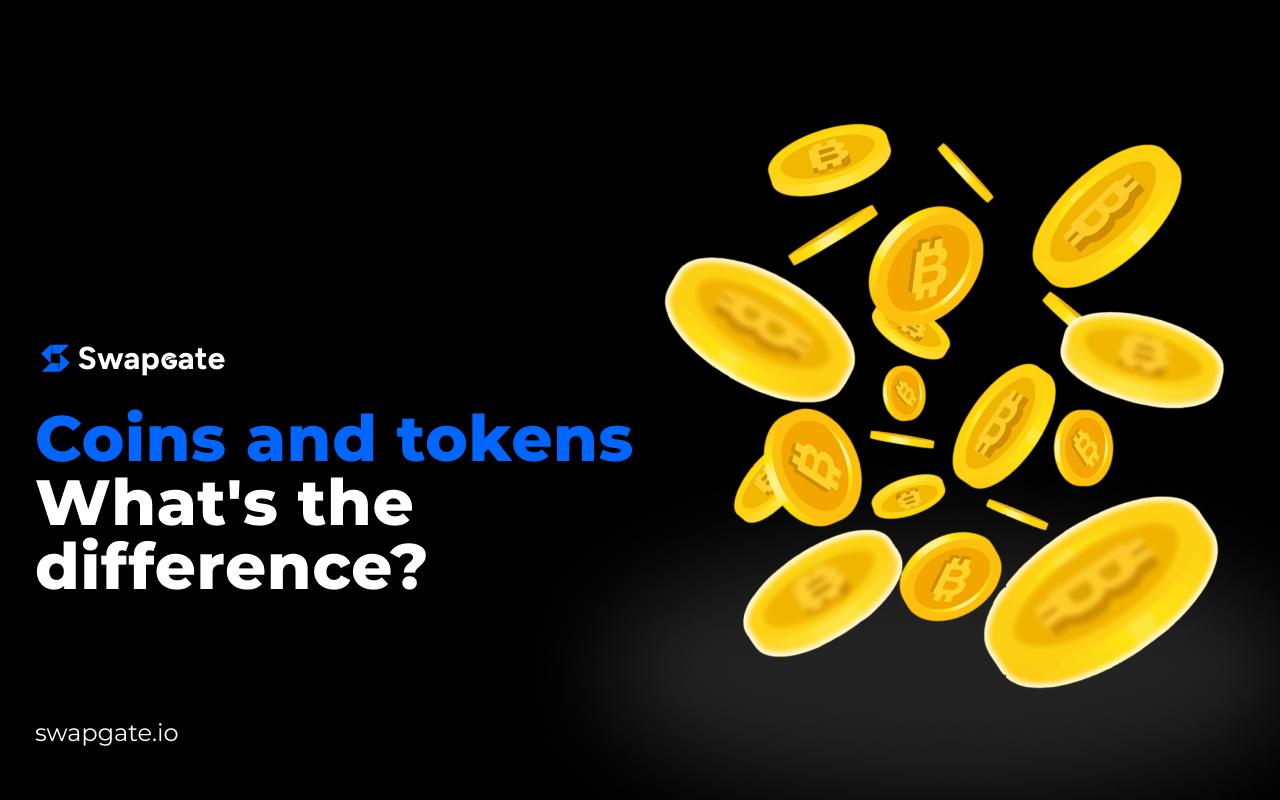
Understanding the difference between them is crucial for navigating the $2.5T crypto market in June 2025. This guide breaks down cryptocurrencies, revealing the coin and token difference to help you invest smarter on Swapgate. Let’s dive into what is the difference between coin and token!
The Key Difference Between
Coins have their own native blockchain, like Bitcoin’s or Ethereum’s, acting as digital money. Tokens live on existing blockchains, like USDT on Ethereum, representing assets or app functions. This difference between crypto shapes their purpose, creation, and risks, setting the stage for deeper exploration (Coinbase).
What Is a Crypto Coin?
A crypto coin is the native currency of a blockchain, akin to dollars in a country’s economy. Coins like Bitcoin (BTC, $69K, $100B daily volume) or Ethereum (ETH, $3,500) power their networks, paying for transactions or smart contracts. They’re standalone, requiring miners or validators to secure the chain, with $1T in coin market cap (CoinMarketCap). Cryptocurrency coin mining is foundational to their ecosystems (Kraken).
Key Functions and Examples of Coins
Coins serve as:
- Digital Money: Store of value or payment (BTC, $50B transacted daily).
- Gas Fees: Pay network costs (ETH, SOL for DeFi ops, $5M daily fees, DefiLlama).
- Infrastructure: Support dApps (Solana, 1B transactions, Solana Foundation).
Examples: Bitcoin (BTC), Ethereum (ETH), Solana (SOL).
What Is a Crypto Token?
Is a digital asset built on someone else’s blockchain, like an app on iOS. Tokens don’t have their own blockchain but use existing ones (e.g., Ethereum’s ERC-20 standard) for $200B in DeFi activity (DefiLlama). They represent utilities, assets, or rights within projects, making them versatile in the token and coin landscape.
The Many Functions
What is the difference between a utility token and a simple:
- Utility: Grant access (Chainlink’s LINK, $700M staked for oracles, Chainlink).
- Governance: Enable voting (Uniswap’s UNI, $5B TVL, Uniswap).
- Stablecoins: Pegged to fiat (Tether’s USDT, $110B cap, CoinMarketCap).
- Security: Represent assets (none mainstream in 2025, due to SEC rules, CoinTelegraph).
- NFTs: Unique assets (Bored Apes, $20K floor, OpenSea).
USDT is a token, running on Ethereum (ERC-20) and TRON (TRC-20), not its own blockchain.
Comparison Table
| Feature | Crypto Coin | Crypto Token |
| Native Blockchain | Owns one (e.g., Bitcoin, Ethereum) | Uses another’s (e.g., USDT on TRON) |
| Primary Purpose | Digital money, network fees | App-specific (access, voting, assets) |
| Creation | Mined/staked, complex | Issued via smart contracts, simpler |
| Examples | BTC, ETH, SOL | USDT, LINK, UNI |
Why the Difference Matters
Why does the difference between coin and token in cryptocurrency matter? It impacts investment, usage, and risks:
- Investment Perspective: Coins like BTC are stable, betting on infrastructure ($1T cap), but slow-growing. Tokens like UNI are riskier, tied to specific apps ($5B TVL), offering high-reward potential (10x UNI in 2024, CoinGecko). How does the difference affect investment potential and risks? Coins suit conservative portfolios; tokens appeal to speculators (@CoinDesk).
- Transaction Costs: Need ETH to move ERC-20 tokens ($5–$50 gas, GasFees.io), but coins are self-sufficient.
- Project Scope: Can a single project have both a native coin and multiple different tokens? Yes, Ethereum’s ETH powers the chain, while ERC-20 like DAI runs dApps (DefiLlama).
BNB began as an ERC-20 on Ethereum, becoming Binance Chain’s native coin in 2019 (Coinbase). Tokens are easier, issued via smart contracts (e.g., 10K ERC-20s, Etherscan), while coins require building a blockchain, costing $10M–$100M.
Frequently Asked Questions
Are all tokens the same?
No, fungible (e.g., USDT, interchangeable) differ from NFTs (unique, e.g., CryptoPunks). Utility tokens (LINK) provide access, while security (rare) represent assets, per SEC (Kraken).
Can a token become a coin?
Yes, projects like TRON (TRX, from ERC-20 to native coin) migrated to own blockchains (CoinGecko).
Which is a better investment?
Coins offer stability (BTC’s 15% volatility vs. UNI’s 50%, CoinMarketCap); tokens promise growth but risk failure (80% DeFi tokens dip 90%, DappRadar).
How do layer-2 solutions affect the relationship between a native coin and its tokens?
Layer-2s like Arbitrum reduce Ethereum’s $5–$50 gas fees to $0.01, making ERC-20 token transfers cheaper but still requiring ETH (GasFees.io). This strengthens ETH’s utility while boosting adoption (e.g., 20% Arbitrum TVL growth, DefiLlama). Utility tokens (e.g., LINK) grant platform access; security tokens (e.g., tokenized real estate, rare in 2025) represent ownership, facing stricter SEC rules.
Conclusion: Choosing Between Cryptocurrency Coins and Tokens
The cryptocurrency distinction is foundational. Coins like BTC and ETH are blockchain-native, powering $1T in infrastructure. Tokens like USDT and UNI thrive on these chains, driving $200B in apps. This confrontation matters for investing—coins for stability, tokens for growth. Difference between coin and token in cryptocurrency shapes your strategy. Explore both on Swapgate’s 0.5% fee platform, trading 1,600+ pairs, and dive deeper with our guides in 2025.